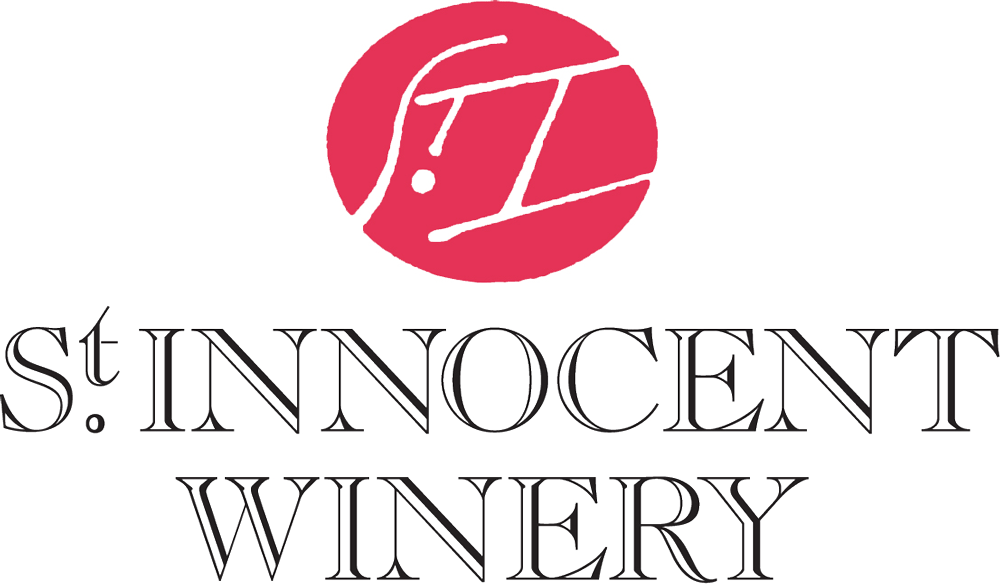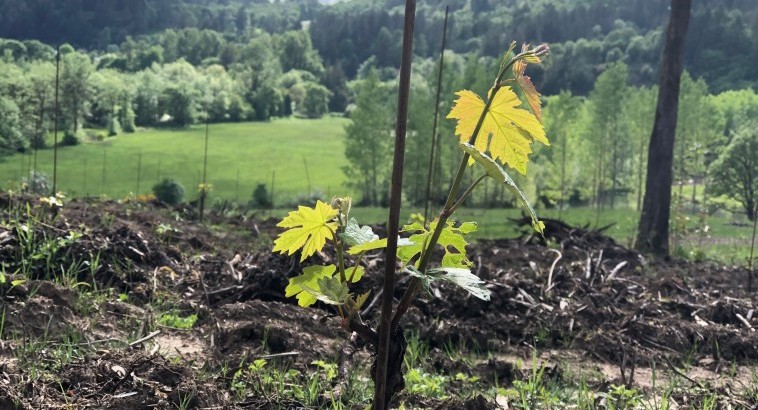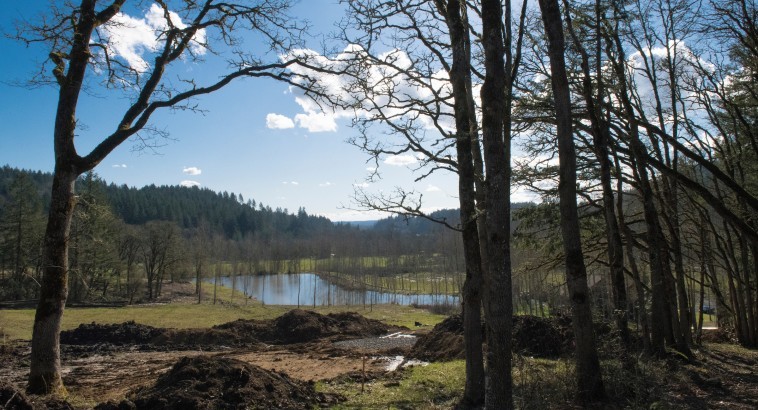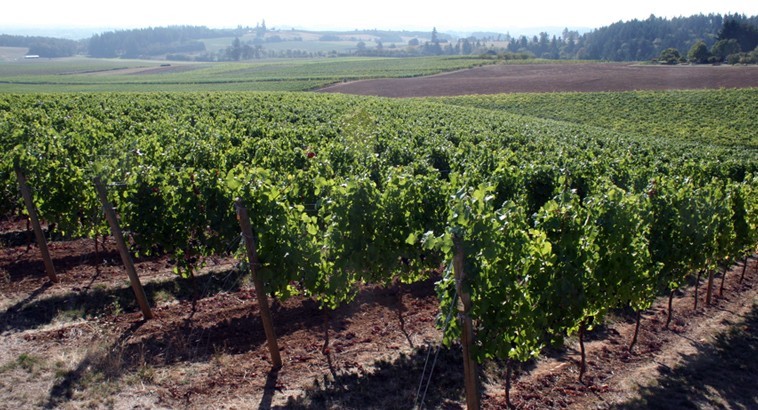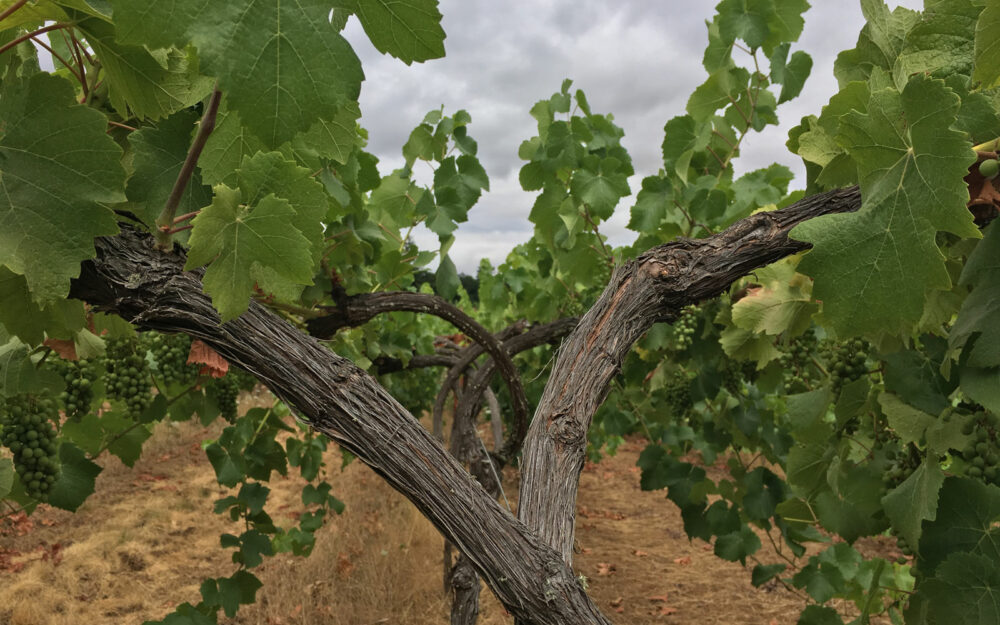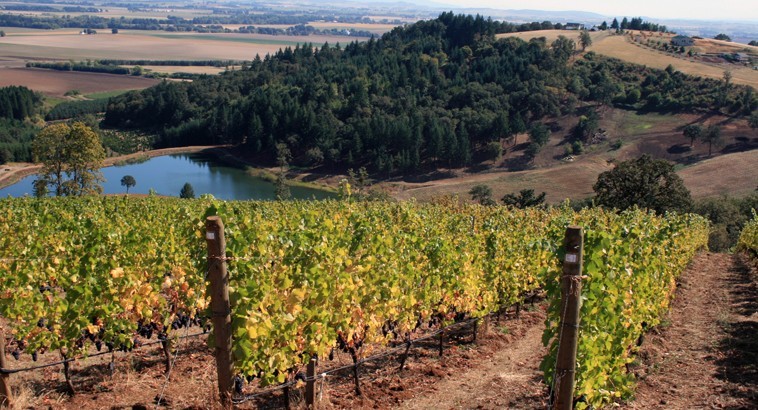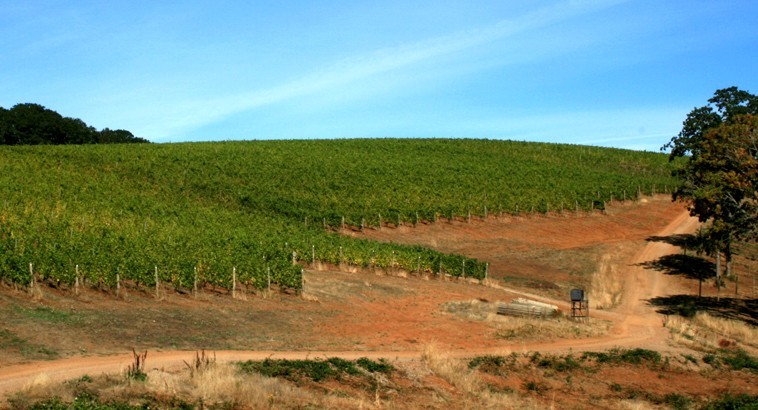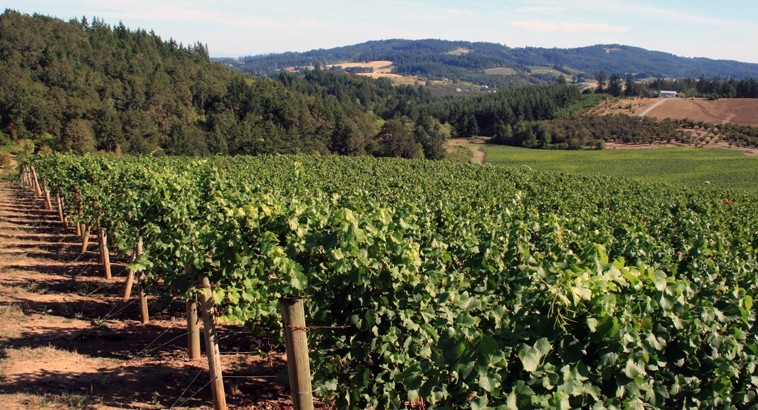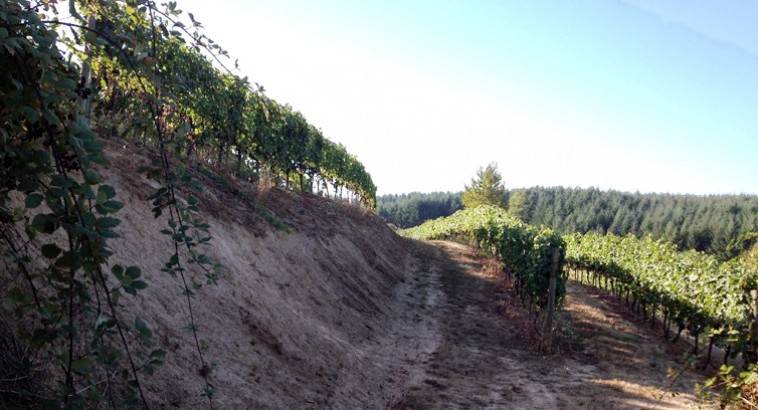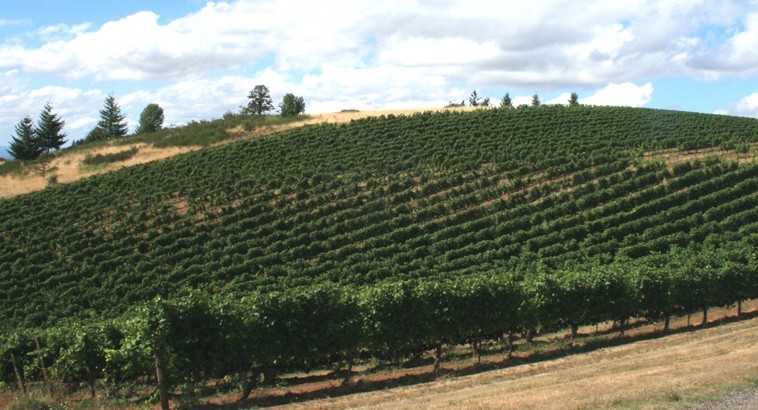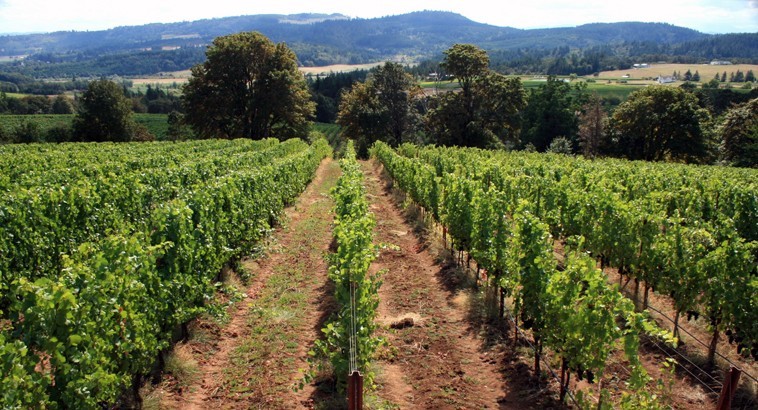VINEYARDS
We believe great wines begin in the vineyard
Burgundy and Alsace have a rich history of growing Pinot noir, Chardonnay, Pinot blanc, and Riesling, all known for their food flexibility and potential ability to capture a “Sense of Place.”
It is well known in the Old World that the large majority of vineyard sites cannot reveal a Sense of Place. Only 16% of Burgundy is Premier or Grand Cru. Generally, winemakers accept that Village level vineyards are best when blended from multiple sites. There is no evidence that the New World is any different. In Europe, you look at a map; after centuries of growing wine grapes, the great sites reveal themselves. There is no such map of the New World.
Mark’s innate abilities (and a dash of luck) have led us to several great sites that reveal this “Sense of Place.” In the article “Five Great Oregon Vineyards,” the author noted that St. Innocent was the only winery at that time that made wine from all five sites: Freedom Hill, Shea, Momtazi, Temperance Hill, and Zenith.
The unique characteristics of each of our vineyard sites create distinct personalities in our wines. The soil type, orientation to the sun, altitude, and relative daytime and nighttime temperatures affect how the vine grows and how the grape transforms into wine. It enables us to make distinctly different wines from the same varietal.
Farming techniques that respect the earth enhance the ability of the land to reveal its unique flavors and textures, which is the first step in producing wines that reflect their terroir. We work closely with our growers to fine-tune viticultural techniques – pruning, leaf pulling, crop thinning, hedging, and picking – to produce grapes that reflect the flavor and texture of each unique site. We obtain fruit from vineyards certified in various sustainable farming methods: LIVE, Organic, and Biodynamic.
Work in the vineyard focuses on achieving balance in the vines and allowing the plants to produce the best fruit possible, even under challenging conditions. We contract for vineyard blocks grown specifically for St. Innocent Winery on a long-term basis. Our relationship with these growers enables us to access top-quality fruit from diverse locations; this makes it possible for us to produce wines that reflect the unique growing conditions at each site.
Wine grapes, especially Pinot noir, are influenced by where they are grown. The regional climate determines the characteristics of the growing season: the amount of heat, sun, and wind. The Willamette Valley has enough sun and heat to ripen Pinot noir but not much more. The grapes ripen late in the fall, allowing maximum flavor development while maintaining their acidity. We are blessed; there are very few places in the world where this occurs.
All of the Willamette Valley is affected by winds blowing from the Pacific Ocean through the Van Duzer Corridor eastward. The winds begin blowing in the late afternoon acting to cool the vines. These winds shorten the growing day, cool the clusters, and help the vines retain acidity. The stronger the wind’s effect, the darker the fruit profile and more spice in the wine.
St. Innocent produces wines from grapes grown in the northern Willamette Valley, from the edge of Portland to just south of Salem. We work with seven different vineyards, including our own estate. Within these vineyards there are significant variations in soil type, soil depth, elevation, mesoclimate, and exposure. These differences are at the heart of what we think of as each site’s terroir, the French term that encompasses a sense of the place the grapes come from. In a very real sense, our relationship with these growers and the vineyards they farm define the wines we produce.
Farming techniques that respect the earth enhance the ability of the land to reveal its unique flavors and textures. This is the first step in producing wines that reflect their terroir. We obtain fruit from vineyards certified in various methods of sustainable farming: LIVE, Organic, and Biodynamic. Work in the vineyard focuses on achieving balance in the vines and allowing the plants to produce the best fruit possible, even under difficult conditions. Maintaining a close working relationship with our growers allows collaborative fine-tuning of viticultural techniques to produce the best possible fruit.
Enchanted Way Vineyard
AVA: Willamette Valley
Fruit Sourced: Pinot noir, Chardonnay
Enchanted Way Vineyard was planted in 2018 after St. Innocent purchased its very own property in the hills of South Salem. The property is currently 47.55 acres, with 15 acres planted to vines. The property features 4 micro-hillsides on which Mark has planted blocks of Pinot Noir & Chardonnay. The four distinct blocks differ in their elevation, aspect, and soil types. Believing this site to be perfect for Chardonnay, Mark has planted the best part of each block with Chardonnay clone 76.
Freedom Hill Vineyard
Freedom Hill Vineyard is located in the foothills of the Oregon Coast Range, 10 miles southwest of Salem. Located further west than most other Willamette Valley sites, it receives the first cooling breezes of the Pacific Ocean in the late afternoon. The result is that the vines go to “sleep” earlier in the evening, consuming less of their acidity for energy at night. The vineyard rises above a large, low, flat valley to the east receiving the first rays of sunshine in the morning. Those long days of sun and warmth rising off the valley floor produce ripe grapes with well developed skins. This combination of sunny, warm days and cool nights leads to mature fruit, ripe tannins, and excellent acidity. We currently have three acres of Pinot blanc, six acres of Dijon clone Chardonnay and seven acres of Pinot noir.
Read More
We began producing Chardonnay from this site in 1992 and Pinot noir in 1994. The vines from our original Pinot noir blocks at Freedom Hill died from phylloxera after the 2003 vintage. Mark and Dan Dusschee, the vineyard’s owner and manager, agreed to replant a 4 acre block on the north edge of the vineyard for St. Innocent Winery’s exclusive use. Planted in 2003, the block has two acres of Wadenswil and two acres of Pommard clone Pinot noir with each clone planted on two different rootstocks (3309 and 44-53). We planted an additional three acres of Pinot noir 777 clone at the very top of the vineyard in 2008.
We began producing Pinot blanc exclusively from this site in 1997 from a 1.8 acre block. We added another 1.2 acres of vines planted in 2008.
Momtazi Vineyard
AVA: McMinnville
Fruit Sourced: Pinot noir, Pinot gris
Partner Since: 2006
Momtazi Vineyard is in the McMinnville AVA, located high above a warm valley that lies between the mouth of the Van Duzer Corridor and the Eola-Amity Hills.
In 2006 St. Innocent began sourcing Pinot noir fruit from this unique site. Located high on a south facing hill overlooking the mouth of the Van Duzer Corridor, the blocks we use are very exposed at the highest elevations of this large vineyard, almost 800’. This exposure creates very sunny conditions from dawn to dusk developing dark and rich skin tannins. The steep hillside of thin, poor soil challenges the vine’s ability to survive. The strong affect of the coastal winds that blow from the Pacific Ocean through the Van Duzer corridor also rapidly cools the vines in the early evening allowing for acid retention. The wines produced from this site reveal this dichotomy: densely dark fruited and rustic with roasted spices.
Read More
Blocks C is planted with 114 clone Pinot noir on 44-53 rootstock. Block B is planted with 667 and 777 clone Pinot noir and blocks BA and C2 are planted with Pommard clone Pinot noir. We currently have 9.1 acres under contract at Momtazi.
A small amount of Momtazi Pinot noir is added to our Villages Cuvée to add weight and extend the finish.
Shea Vineyard
AVA: Yamhill-Carlton
Fruit Sourced: Pinot noir
Partner Since: 1998
Shea Vineyard is located in the Yamhill foothills of the Yamhill-Carlton District AVA, 35 miles southwest of Portland. One of Oregon’s most famous sites. St. Innocent Winery has produced Shea Vineyard since 1998.
It is actually two sites separated by a deep ravine, the East and West fields. Each field has exposures from southeast, south, and southwest and the elevation varies from 400′ to 600′. Dick Shea’s winery, Shea Wine Cellars produces wine from 20% of the vineyard’s production. The rest is sold to approximately 18 different wineries.
Read More
Mark has made wine from Shea Vineyard since 1994, when the vines were just six years old. From 1994-1998, he made them while working as Panther Creek Cellar’s Winemaker. His 1994 Shea Pinot noir received 94 points from The Wine Advocate, at that time the highest score ever given to an Oregon wine. St. Innocent began purchasing Shea Vineyard fruit in 1998.
The Shea Vineyard Pinot noirs we produce embody longevity. Mark considers them to be the most complex and detailed wines he makes and considers Shea to be one of Oregon’s greatest vineyards. We receive Pinot noir from Block 6, which was planted in 2000 and 2002. This 4.5 acre parcel is located in the East Field and is planted with Pommard and Dijon clone 115. It came into full production in 2005. We also get fruit from the 1.8 acre Terrace Block at Shea Vineyard, which was planted in 1990, originally with Pinot gris. This block is located on a steeply terraced southwest slope at the west side of the east hill. It was replanted with Pinot noir between 2000 and 2005 as the original Pinot gris plants died of phylloxera.
Temperance Hill Vineyard
AVA: Eola-Amity Hills
Fruit Sourced: Pinot noir, Chardonnay, Riesling
Partner Since: 1994
Temperance Hill Vineyard is located in the middle of the Eola-Amity Hills AVA. It is the highest vineyard producing fruit in the south end of the Eola-Amity Hills AVA. We use three different blocks ranging from an elevation of 660′ to almost 860′. The “East Block” is planted with Pommard clone in 1982 and still has original, own-rooted Pinot noir. It has been infected with phylloxera since 2000 and is slowly declining. We replanted 1.5 acres of Pommard clone Pinot noir on resistant rootstock at three times density than the original vineyard in 2014. With the loss of the original vines, we also planted 1.5 acres at the top of the hill with two clones of Riesling and 1.1 acres of Dijon-Clone Chardonnay (for sparkling wine). We continue to re-plant Pinot noir in the rest of the East Field as we lose the original vines (probably with 667 and 115).
Read More
Between the two ridges of Temperance Hill is a long, east-west saddle called the “R” Block. At the SW corner, we have a long south-facing 4.5 acre strip which came into production in 2010. This is planted with the Pommard clone of Pinot noir. The vineyard is managed by Dai Crisp, one of Oregon’s great grapegrowers, and is farmed and certified organic.
